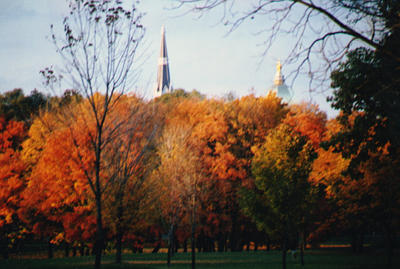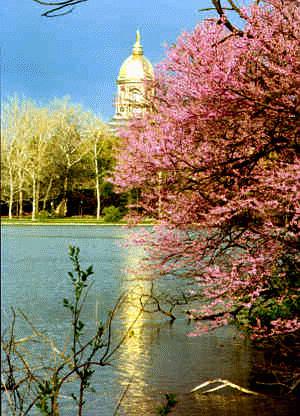
Notre Dame's Grotto / by Dorothy V. Corson

A Letter from Kenton Kilmer
Kilmer was quoted as saying: "I can honestly offer "Trees" and "Main Street" to Our Lady and ask her to present them as the faithful work of a poor unskilled craftsman, to her son."(175) The priest who wrote the brochure about Kilmer and the Notre Dame Grotto was also a friend of Father O'Donnell. Perhaps, he had repeated something he remembered him saying about Kilmer and used the "they say" because he couldn't confirm it.
Father Schidel said that Belloc, a fellow poet of Joyce, spoke of "poetry being the distillation of the mind." He offered the theory that Joyce may have written the poem in the bedroom of his home, but he might have been affected by trees he had seen in many localities, and his thoughts may have "jelled" into a poem upon looking out his window at the trees in his yard. In other words, we know where the poem was written, but probably only God knows where and when it was inspired.

A reply from Kenton, in which he responds to Father Schidel's observation, concluded the Kilmer research admirably:
Mother and I agreed, when we talked about it, that Dad never meant his poem to apply to one particular tree, or to the trees of any special region. Just any trees or all trees that might be rained on or snowed on, and that would be suitable nesting places for robins. I guess they'd have to have upward-reaching branches, too, for the line about 'lifting leafy arms to pray.' Rule out weeping willows.
. . . I think Father Schidel's opinion is just right and in complete accord with what my mother and I agreed on. Dad meant trees in general, was surely thinking of the trees he was looking at, and probably of trees he had seen in the past, such as the famous one on the Rutgers campus. But what he was thinking and saying applies equally to trees he didn't see until later, or trees he never would see. Dad would surely be pleased with Father Schidel's citation of the Belloc quotation, for its aptness to the subject, because Dad was a fervent admirer of Belloc's poetry.
. . . It is plain from comments in my father's letters, . . . that Dad's devotion to Christ was always joined with the love of His Mother. I am sure that a grove of trees dedicated to the Blessed Virgin could have inspired him to write such a poem as 'Trees', if the poem had not already been written.(176)
Kilmer was on campus in the fall of 1913, the year he wrote and published "Trees" (February 2, 1913). However, there was no evidence to prove that he had visited the campus and the Grotto prior to the time he wrote it, although it was very possible.
Short of an affirmative answer, it was a most satisfying conclusion to a study of Kilmer and his association with the University and the Notre Dame Grotto.
Joyce Kilmer's "Trees," and Tom Stritch's view of the Notre Dame campus from his book, My Notre Dame, express, so well, the warmth and welcome received from trees:

Few American colleges can rival its layout, none its trees. Of all the things to look at around Notre Dame I think I like the trees the best. . . . I seldom look at that island without thinking how lovely its redbud trees look from the Grotto lawn in the spring.(177)
Another appreciator of trees, Father Cornelius Hagerty, an avid canoeist, made this interesting observation about their special appeal to lovers of nature: "Trees stand still and let you look at them and are there at all seasons."(178)
Their words evoke a mental image of Joyce Kilmer circling St. Mary's Lake with Father O'Donnell, pausing in the shade of the Grotto lawn, and admiring that "perfect tree" shading Our Lady's niche.
The essence of Kilmer and his poem "Trees," written by Rev. Thomas J. O'Donnell, C.S.C. '41, appeared in a 1963 Scholastic .
The canopy of trees, digging their roots into the unhewn rock, is the proudest grove on campus. And rightly so. These trees are a garland of green on a crown of rocks. They have lived up to all the beauty of Kilmer's poem . . . as all trees must. But these have done more. They have listened to May songs; they have watched flickering vigil lights; they have stood as silent sentinels while anxious prayers and burdened hearts lifted hopeful eyes to Our Lady. The trees of the Grotto -- if they could speak -- would speak only in a whisper. . . .(179)